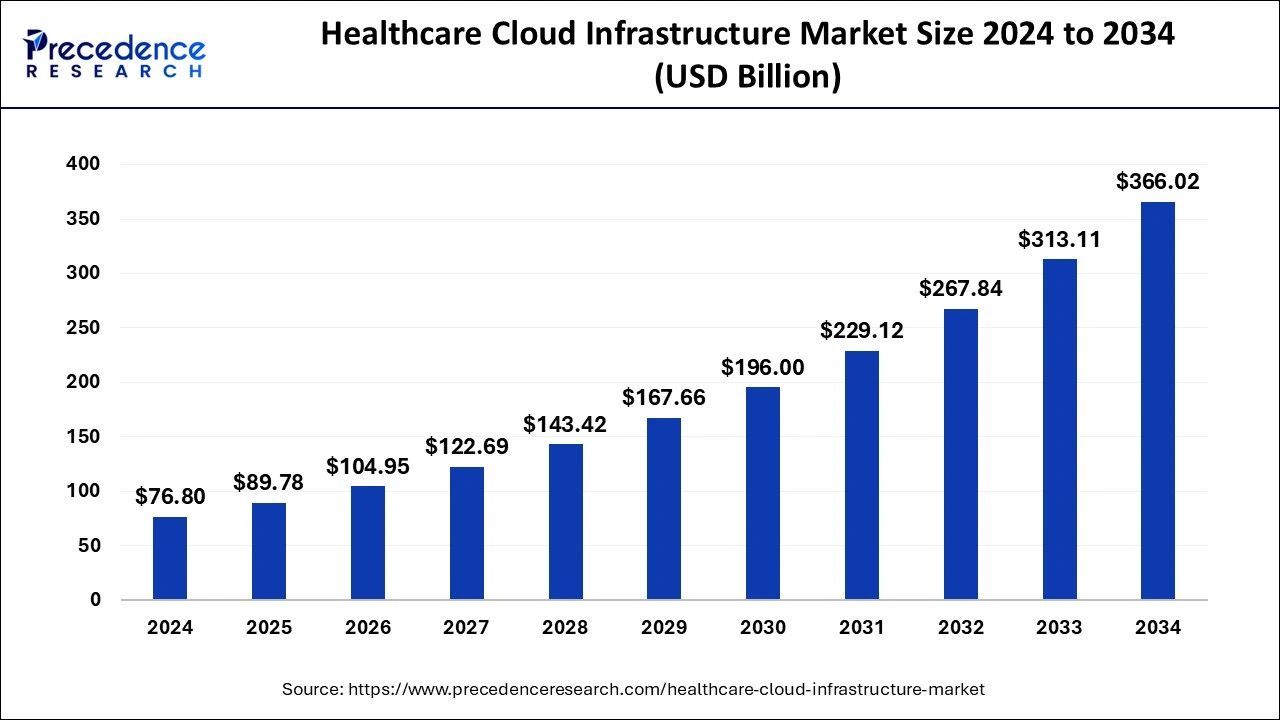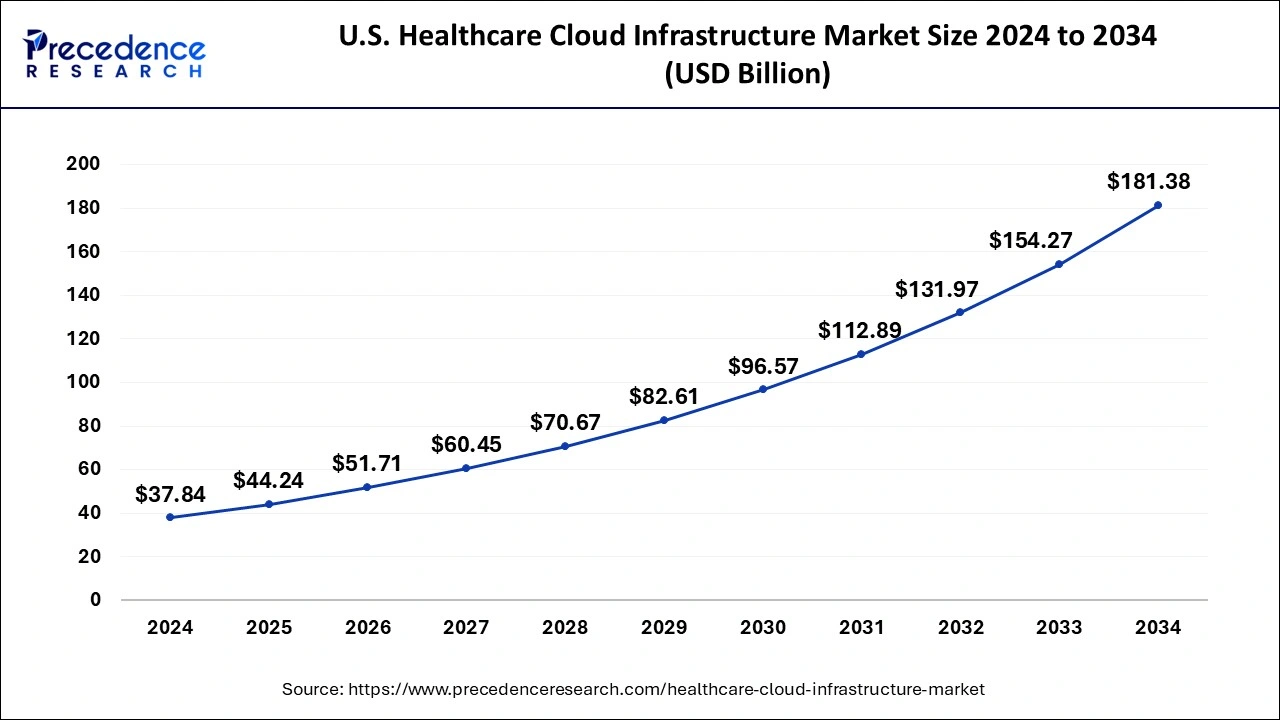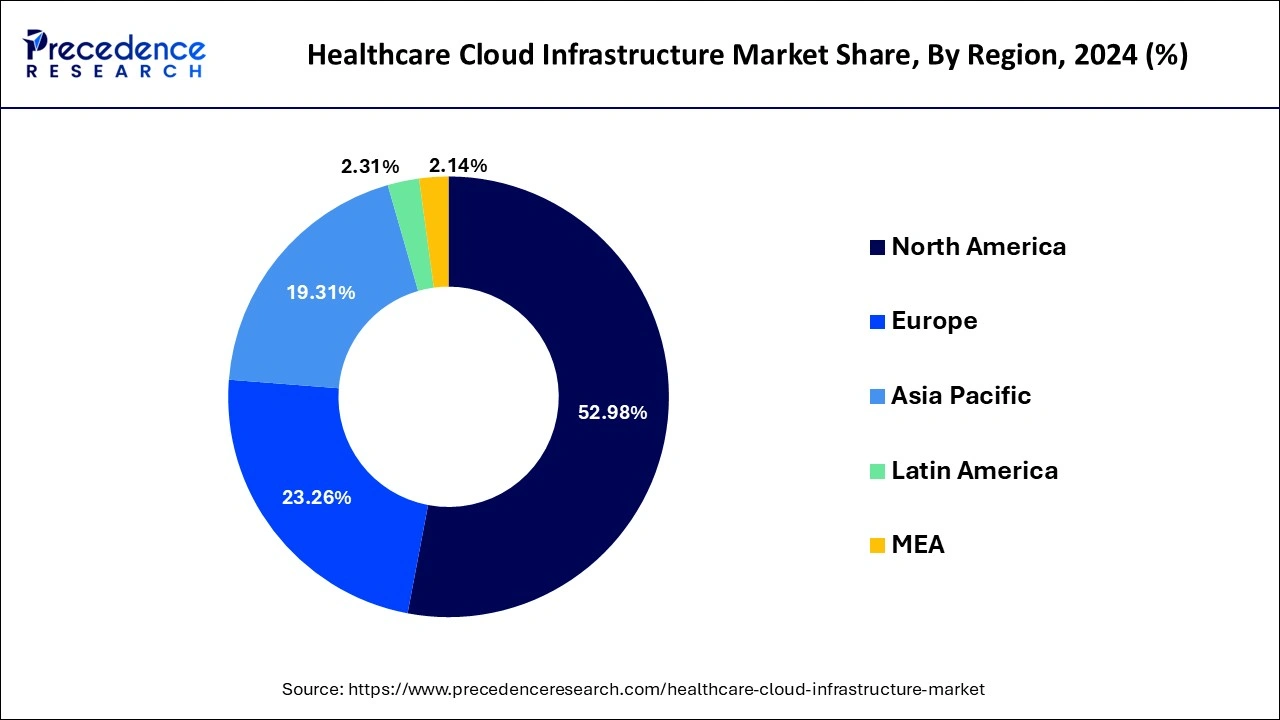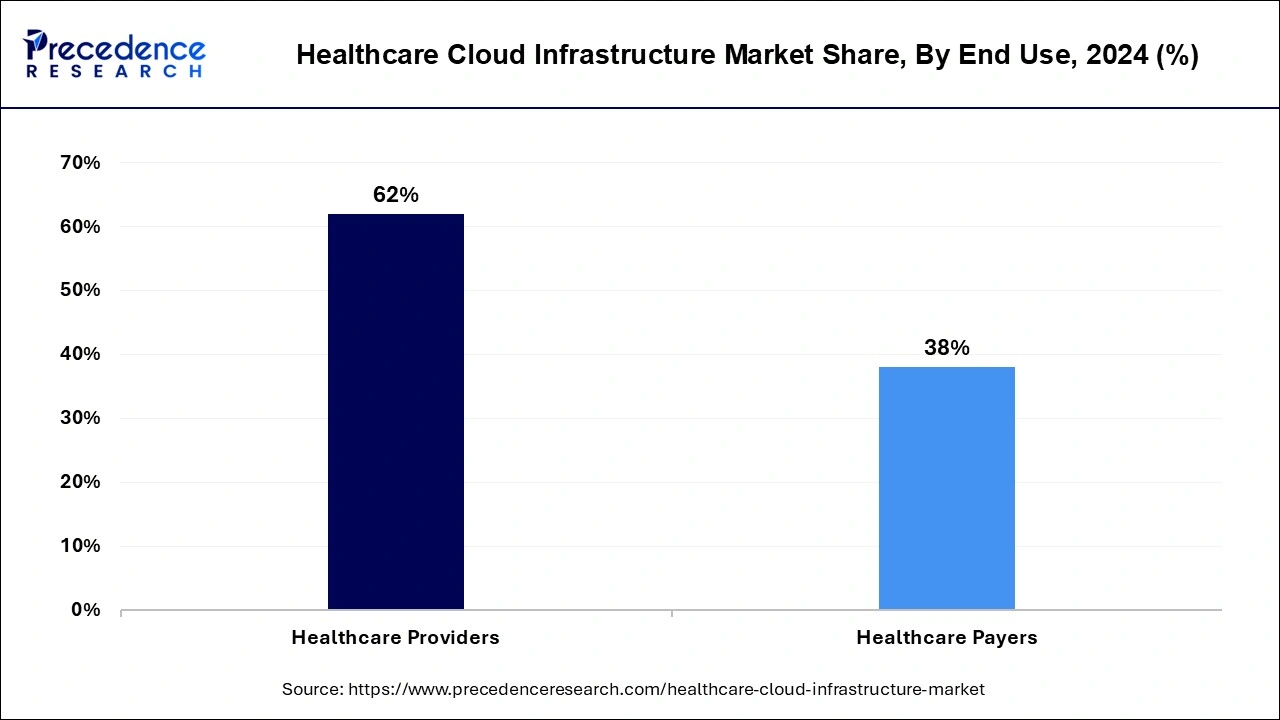January 2025
The global healthcare cloud infrastructure market size is calculated at USD 89.78 billion in 2025 and is forecasted to reach around USD 366.02 billion by 2034, accelerating at a CAGR of 16.90% from 2025 to 2034. The North America healthcare cloud infrastructure market size surpassed USD 40.69 billion in 2024 and is expanding at a CAGR of 16.91% during the forecast period. The market sizing and forecasts are revenue-based (USD Million/Billion), with 2024 as the base year.
The global healthcare cloud infrastructure market size was estimated at USD 76.80 billion in 2024 and is anticipated to reach around USD 366.02 billion by 2034, expanding at a CAGR of 16.90% from 2025 to 2034. Growing awareness related to the presence of advanced technology and increased adoption of remote monitoring and telehealth help the growth of the healthcare cloud infrastructure market.

Artificial intelligence (AI) based systems can optimize patient flow, improve resource allocation, and reduce weight times. AI algorithms can double-check and verify human decisions, minimizing errors in diagnosis, treatment, and administrative tasks. AI helps to personalize treatment plans, improve patient care, improve diagnostic accuracy, and improve decision-making. AI's ability to aid in health diagnosis also improves the speed and accuracy of patient visits, leading to faster and more personalized care. These factors help the growth of the healthcare cloud infrastructure market.
The U.S. healthcare cloud infrastructure market size was evaluated at USD 37.84 billion in 2024 and is predicted to be worth around USD 181.38 billion by 2034, rising at a CAGR of 16.96% from 2025 to 2034.

North America led the global healthcare cloud infrastructure market with the largest market share of 52.98% in 2024. The increased adoption rate of the IT solutions in the healthcare sector and the increased healthcare expenditure are the major factors behind the growth of the North America market. The presence of several top IT companies in the region such as IBM, Dell, Microsoft, and Amazon are significantly contributing towards the growth of the market. Moreover, the supportive regulatory framework is supplementing the adoption of the cloud infrastructure and the demand for the telehealth across the region, which is expected to drive the growth of the North America healthcare cloud infrastructure market.

Asia Pacific is projected to grow at the fastest CAGR during the forecast period. The rapidly growing number of several start-ups specializing in the healthcare cloud solutions and services is expected to drive the growth of the market in this region. Moreover, the increasing investments in the development of strong digital healthcare infrastructure and growing adoption of the advanced solutions is boosting the Asia Pacific healthcare cloud infrastructure market. Furthermore, the growing adoption of the smartphones and rising internet penetration is boosting the adoption of the telehealth platforms among the hospitals and consumers. The rapidly growing IT and telecommunication infrastructure in the region is supplementing the growth of the market significantly.
| Report Coverage | Details |
| Market Size in 2025 | USD 89.78 Billion |
| Market Size by 2034 | USD 366.02 Billion |
| Growth Rate From 2025 to 2034 | 16.90% |
| Largest Market | North America |
| Base Year | 2024 |
| Forecast Period | 2025 to 2034 |
| Segments Covered | Component, End User,Deployment Model, Pricing Model, Region |
| Regions Covered | North America, Europe, Asia-Pacific, Latin America, and Middle East & Africa |
Rising adoption of digital technologies
The increasing demand for digital technologies among healthcare professionals significantly contributes to market growth. In line with this, the rising patient population suffering from various diseases is raising the need for efficient data management tools. Healthcare cloud computing provides patient information through secured networks. It eliminates data privacy concerns.
The growing acceptance of these technologies and the market players' collaboration strategy catalyze market growth. The shift of the healthcare industry toward an information-centric model creates a positive outlook for the market. The data automation storage and IoT support offered by cloud computing solutions accelerate its demand. The higher usage of digital platforms in healthcare organizations and government support propels market growth. The integration of cloud computing services in hospitals fuels market expansion.
Surged preference and adoption for healthcare cloud computing
The increasing preference and adoption of healthcare cloud computing solutions across healthcare organizations offer various market growth opportunities. The growing government initiatives that support data safety and integrity catalyze market growth. The favorable regulatory scenario and healthcare professionals' rapid adoption of cloud computing software strengthen market growth. The rising awareness regarding the availability of technologically advanced computing software in developed countries stimulates its demand. Its ease of interoperability, telemedicine capabilities, and reduction of costs are a few benefits it offers. Healthcare cloud computing is beneficial for both patients and healthcare professionals. The widespread usage of healthcare cloud computing solutions favors market growth.
Data safety concerns associated with cloud computing solutions
There are various data concerns in cloud computing software that restrict market growth. The data is not safe, which is a matter of concern. Cloud computing software and servers are often subject to cyber attacks. Cybercriminals are now employing newer methods, such as social engineering, to gain access to sensitive and protected patient information. Data loss is also another major concern, with accidental deletion, system failures, or improper data management potentially leading to data loss in the cloud.
IT infrastructural constraints in developing economies
The IT infrastructural constraints in developing countries challenge market growth. The cost issue is a lack of appropriate connectivity infrastructure that will lead to the adoption of these solutions. The maintenance and software update expenses are high. The shortage of internal IT expertise in the medical industry hampers the market growth. The implementation costs of healthcare IT solutions are very high. Thus, the high costs limit hospitals from investing in healthcare IT solutions across developing countries.
Tthe hardware segment accounted for the highest market share of 81% in 2024 and dominated the global healthcare cloud infrastructure market. The increased demand for the various technical service providers to implement the digital computing systems across the hospital or health units. The companies and the organizations has lack of skills and resources needed to deploy the cloud computing technologies. Furthermore, the easy availability of the IT professionals has encouraged the healthcare units to outsource the activities related to the implementation of the cloud technologies.
The services segment is projected to grow at a notable CAGR during the forecast period. The hardware is an essential part in the implementation of the cloud-based solutions. The hardware includes the advanced electronic devices and machine to human interface devices that has higher computing power and best suits the operation of the cloud infrastructure has growing demand.
The healthcare providers segment has held the major market share of 62% in 2024. This is attributed to the huge demand in the hospitals for the connections over the cloud infrastructure, which has significantly and positively contributed towards the growth of the Software-as-a-Service (SaaS) segment. The easy availability of IT outsourcingservices, elimination of the IT professionals, enhanced data storage, and data management are the major factors that boosts the growth of this segment. The increasing investments in the digitization of the hospitals is further expected to drive the market growth.

The healthcare payers segment is expanding at a significant CAGR during the forecast period. The various healthcare payers such as healthcare insurance companies, sponsors, and third-party payers are adopting cloud technologies for efficiently handing data, fraud prevention, risk assessment, and settling insurance claims. The healthcare payers are increasingly opting for the cloud technologies for reducing the costs of healthcare.
By Component
By End Use
By Geography
For inquiries regarding discounts, bulk purchases, or customization requests, please contact us at sales@precedenceresearch.com
No cookie-cutter, only authentic analysis – take the 1st step to become a Precedence Research client
January 2025
December 2024
February 2025
April 2024